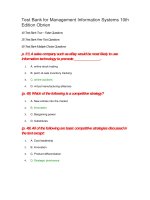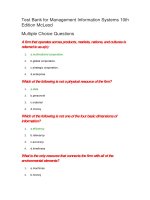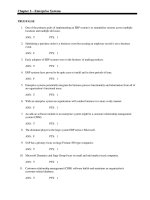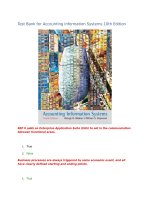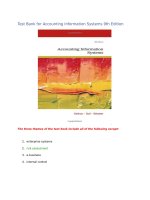Solution manual for accounting information systems 10th edition by bodnar
Bạn đang xem bản rút gọn của tài liệu. Xem và tải ngay bản đầy đủ của tài liệu tại đây (292.97 KB, 36 trang )
bu
y
Chapter 1
ACCOUNTING INFORMATION SYSTEMS: AN OVERVIEW
TEACHING TIPS
This chapter provides general coverage of many of the text's major themes. It's usually a good idea to
indicate how the topics covered in this chapter will be covered in more detail later in the course.
Many instructors will not assign any problem from the end of this chapter. This can be done without
any loss of overall continuity in the course.
2 1 Accounting Information Systems: An Overview
If the course will emphasize internal controls, it might be desirable to cover in class one of the general
cases on internal control from the back of Chapters 4, 7, or 8. This should be done to stimulate student
interest, but the instructor should not worry if the students in the course fail to analyze the case
correctly.
In some ways, teaching systems can be more difficult than teaching other areas. In many cases there
are no clear-cut debits and credits to be made, and judgment is often required. This can make some
students feel uncomfortable. So it's usually good to emphasize this at the beginning of the course to
properly set students' expectations. The point should also be made that systems are an important area of
professional examinations.
One of the biggest risks in teaching systems is that it can easily become dry and boring. I have found
that the best way to overcome this is to generate as much class discussion as possible on many of the
major points in the chapter. Accordingly, I always make class participation about one-fourth of the total
course grade. I tell students on the first day of class that as a starting point I will give all students the
same number of points (reflecting a class average) for participation. Then, at the end of the course, I
will typically add or subtract 5, 10, or 15 points to/from each student's grade according to the
participation. Many students typically stay at the average, so only noteworthy students end up with an
adjustment. I always use a seating chart, unless the class is small.
Many of my students have had jobs. So one question that I constantly ask throughout the term is "Has
anyone experienced this before in their job or otherwise?"
ACCOUNTING INFORMATION SYSTEMS AND BUSINESS ORGANIZATIONS
Ful
l
An accounting information system is a collection of resources, such as people and equipment,
designed to transform financial and other data into information. Accounting information systems
perform this transformation whether they are essentially manual systems or thoroughly computerized.
Information and Decisions. The users of accounting information fall into two broad groups: external
and internal. Higher level managers require less information detail than lower level managers. A
distinction might be drawn between two broad classes of accounting information: mandatory and
discretionary.
Conceptually, information should satisfy a cost-benefit criterion. In meeting mandatory information
4 1 Accounting Information Systems: An Overview
requirements, the primary consideration is minimizing costs while meeting minimum standards of
reliability and usefulness. When the provision of information is discretionary, the primary consideration
is that the benefits obtained exceed the costs of production.
Information Systems. A "computer-based" information system is a collection of computer hardware
and software designed to transform data into useful information.
Electronic Data Processing (EDP or DP): the use of computer technology to perform an
organization's transaction-oriented data processing.
Management Information Systems (MIS): use computer technology to provide decisionoriented information to managers. An MIS provides a wide variety of information beyond that
which is associated with DP in organizations. MIS subsystems are not physically independent.
Examples of MIS subsystems are as follows:
Marketing information system
Manufacturing information system
Human resource information system
Financial information system
Decision Support Systems (DSS): process data into a decision-making format for the end user.
DSS serve ad hoc, specific, non-routine information requests by management, including what-if
analyses.
Expert Systems (ES): knowledge-based information systems that use knowledge about a
specific application area to act as an expert consultant to end users. An ES differs from a DSS
Ful
l
in that a DSS assists a user in making a decision, whereas an ES makes the decision.
Executive Information Systems (EIS): tailor information to the strategic information needs of
top-level management.
Accounting Information Systems (AIS): include transaction processing cycles, the use of
information technology, and the development of financial information systems.
ACCOUNTING INFORMATION SYSTEMS AND APPLICATION ARCHITECTURE
Accounting information systems and information technology (IT) are strongly intertwined. The
6 1 Accounting Information Systems: An Overview
fundamental benefits of information technology are automation, information organization, and
communication. Applications Architecture involves the process of ensuring the suite of organization’s
applications work together as a composite application according to the goals and objectives of the
organization. Architecture has evolved automating the traditional accounting cycle to enhancing
functional planning and control within the organization. Material Requirements Planning (MRP)
software assisted management in managing inventories and scheduling production. MRP evolved into
MRP II, (Manufacturing Resource Planning II) which added new capabilities. MRP and MRP II paved
the way for Computer Integrated Manufacturing (CIM) and Flexible Manufacturing Systems (FMS). In
CIM, computers take control of the entire manufacturing process, and in FMS computers not only
control production processes but can also be reprogrammed so that the same processes can produce
entirely different products. Enterprise Resource Planning (ERP) involves the combining of the various
functional information systems under the umbrella of a single software package and a single database.
ERP II adds collaborative commerce to ERP. Collaborative commerce involves groups of
organizations working together toward common goals, such as new products, new process methods,
and human capital intelligence. In recent years the ERP system has given way to the Enterprise
Application Suite (EAS). The EAS replaces one monolithic ERP software package with a group (i.e., a
suite) of individual packages that work closely with each other and run in web browsers.
BUSINESS PROCESSES
A business process is an interrelated set of tasks that involve data, organizational units, and a logical
time sequence. A key characteristic of business processes is that they are not necessarily limited to a
single functional area of the information system or the organization chart.
Ful
l
Business Process Reference Models.
The basic business processes can be organized and grouped together according to various reference
models, depending on the desired emphasis.
The ERP Functional Model
The Value Chain Model
The Supply Chain Model
The Operations Process Model
The Transaction Cycle Model
Transaction Processing Cycles
Revenue cycle. Events related to the distribution of goods and services to other entities
and the collection of related payments.
8
1 Accounting Information Systems: An Overview
Expenditure cycle. Events related to the acquisition of goods and services from other
entities and the settlement of related obligations.
Production cycle. Events related to the transformation of resources into goods and
services.
Finance cycle. Events related to the acquisition and management of capital funds,
including cash.
The transaction cycle model of an organization includes a fifth cycle - the financial reporting
cycle. The financial reporting cycle is not an operating cycle. It obtains accounting and
operating data from the other cycles and processes these data in such a manner that financial
reports may be prepared.
Internal Control Process
The term internal control process suggests actions taken within an organization to regulate and direct
the activities of the organization.
Elements of Internal Control Process. An organization's internal control process consists of the
policies and procedures established to provide reasonable assurance that specific organizational
objectives will be achieved. An organization's internal control process consists of five elements: the
control environment, risk assessment, control activities, information and communication, and
monitoring. Internal control also calls for the maintenance of adequate records in an effort to control
assets and analyze the assignment of responsibility.
Segregation of Accounting Functions. Segregate record keeping, custody, and authorization.
Ful
l
Internal Audit Function. Internal audit is charged with monitoring and assessing compliance with
organizational policies and procedures. The internal audit function must be segregated from the
accounting function and also have neither responsibility nor authority for any operating activity.
ACCOUNTING AND INFORMATION TECHNOLOGY
The term accounting information system includes the use of information technology to provide
information to users. Computers are used in all types of information systems. Information technology
includes computers, but it also includes other technologies used to process information. Technologies
such as machine-readable bar codes and scanning devices, and communications protocols and standards
such as ANSI X.12, are essential to office automation and quick response systems.
10
1 Accounting Information Systems: An Overview
The Information Systems Function
Every organization that uses computers to process transactional data has an information systems
function, which is responsible for data processing (DP).
Organizational Location. The head of the information systems function is typically called the Chief
Information Officer and is advised by an advisory group called a steering committee.
Functional Specialization. The most prevalent information systems departmental structure is the
assignment of responsibilities and duties by area of technical specialization, that is, function.
Sub-functions include the analysis function, the programming function, the operations function, the
technical support function, and the user support function.
Analysis and programming functions are typically organized by project. In project organization,
analysts and programmers are assigned to specific application projects and work together to complete a
project under the direction of a project leader.
Quick Response Technology.
Quick response systems are essential to the TQP (Total Quality Performance) movement in business.
Quick response systems use several key technologies: Just-in-Time (JIT), Web Commerce,
Electronic Data Interchange (EDI), Radio Frequency Identification (RFID), Computer-Integrated
Manufacturing (CIM), Lean Manufacturing, and Electronic Funds Transfer (EFT).
Ful
l
Lean Manufacturing (or Lean Production) is a general class of production improvement principles that
focus on eliminating waste and improving the smoothness of the production flow.
Retail EFT systems include the telephone wire transfers and telephone payment systems, preauthorized
payment systems, point-of-sale (POS) applications, and automated teller machines (ATMs).
THE ACCOUNTANT AND SYSTEMS DEVELOPMENT
The term accounting information system includes systems development activities that an accountant or
auditor might expect to encounter professionally.
12 1 Accounting Information Systems: An Overview
The Nature of Systems Development. A systems development project ordinarily consists of three
general phases: systems analysis, systems design, and systems implementation.
The systems approach is a process that consists of six steps:
Statement of system objective(s)
Creation of alternatives
Systems analysis
Systems design
Systems implementation
Systems evaluation
Business Process Blueprinting. Blueprinting is the use of generic or industry standards for systems
development, as opposed to the development of a new system.
Behavioral Considerations in Systems Development
The user cooperation needed to operate the system successfully should be ensured during the design of
a system, not afterward. A philosophy of user-oriented design fosters a set of attitudes and an
approach to systems development that consciously considers the organizational context.
Green IT: Designing For Sustainability
The term Green IT has become an acronym for utilizing information technology resources in an
environmentally responsive manner.
Energy Usage. Green data centers use energy-efficient cooling technologies, energy efficient
equipment, and energy efficient building designs to reduce their environmental footprint.
E-waste. E-waste is IT and other electronic products that are at or near the end of their useful
Ful
l
life.
REVIEW QUESTIONS
1.
An accounting information system is a collection of resources designed to provide data to a
variety of decision makers according to their needs and entitlement.
2.
The users of accounting information fall into two broad groups: external and internal. External
users include stockholders, investors, creditors, government agencies, customers and vendors,
competitors, labor unions, and the public at large. Internal users are the managers in an organization.
14 1 Accounting Information Systems: An Overview
3.
Electronic data processing (EDP) is the use of computer technology to perform an
organization's transaction-oriented data processing. Management information systems (MIS) use
computer technology to provide decision-oriented information to managers. In a decision support
system (DSS), data are processed into a decision-making format for the end user. An expert system
(ES) is a knowledge-based information system that uses its knowledge about a specific application area
to act as an expert consultant to end users.
4.
The four common operating cycles of business activity are the revenue cycle, expenditure
cycle, production cycle, and finance cycle.
5.
The term internal control suggests actions taken within an organization to regulate and direct
the activities of the organization.
6.
A controller is in charge of the accounting function. The treasurer is responsible for the
finances of the business.
7.
Internal audit is charged with monitoring and assessing compliance with organizational policies
and procedures.
8.
The most prevalent information systems departmental structure is the assignment of
responsibilities and duties by area of technical specialization, that is, function.
9.
The analysis function focuses on identifying problems and projects for computer processing
and designing systems to satisfy these problems' requirements. The programming function is
Ful
l
responsible for the design, coding, testing, and debugging of computer programs necessary to
implement the system designed by the analysis function. The operations function is charged with data
preparation, the operation of the equipment, and system maintenance. The technical support function
allows specialization in areas such as operating systems and software, data management and database
design, and communications technology. The user support function services end users, much as the
technical support function services personnel of the information systems department.
10.
In project organization, analysts and programmers are assigned to specific application projects
and work together to complete a project under the direction of a project leader. Project organization
focuses responsibility for application projects on a single group, unlike functional organization, in
which responsibility for a specific project is spread across different functional areas.
16
1 Accounting Information Systems: An Overview
11.
A steering committee is the means by which managers of other areas can influence the policies,
budget, and planning of information services.
12.
Blueprinting is the use of generic or industry standards for systems development, as opposed to
the development of a new system. Blueprinting avoids the expense of 'reinventing the wheel'.
13.
An accountant might access accounts receivable data from a company's centralized database,
manipulate them, and then print a report using an on-line data terminal and query language software.
14.
Several technologies important to quick response systems are EDI (Electronic Data
Interchange), UPC bar code identification of products, and scanning technology.
15.
EDI differs from electronic mail in that electronic mail messages are created and interpreted by
humans (person-to-person), whereas EDI messages are created and interpreted by computers.
16.
Components of a CIM system typically include computer-aided design (CAD) workstations,
real-time production monitoring and control systems, and order and inventory control systems. CIM
components are connected by a computer network and equipped with software systems designed to
support distributed operation.
17.
The six steps in the systems approach are:
Statement of system objective(s)
Creation of alternatives
Ful
l
Systems
Systems
Systems
Systems
analysis
design
implementation
evaluation
18.
A philosophy of user-oriented design fosters a set of attitudes and an approach to systems
development that involves users in the design of applications.
ANSWERS TO DISCUSSION QUESTIONS AND PROBLEMS
19. Nature of Transactions - 10 minutes Easy
18 1 Accounting Information Systems: An Overview
A credit sale is not complete until the subsequent billing and collection of funds from the customer.
This question illustrates how a single transaction might consist of several events and also how a
transaction might impact on several cycles (in this case both revenue and finance cycles as discussed in
the chapter). The instructor might note the interdependencies between sales, billings, and cash
collections, as well as the possibilities of sales returns, adjustments, and uncollectibility of accounts.
20. Organizational Location of Audit Function - 10 minutes Easy
Internal auditing should be organizationally independent of the controller or similar office and should
be administratively responsible to top management. The Securities and Exchange Commission and the
major stock exchanges have endorsed this position, as have all of the professional accounting
associations (AICPA, IIA, IMA).
21. Apply the Systems Approach - 20 minutes Easy
The systems approach is a general procedure for the administration of a systems project. The systems
approach can be viewed as a process that consists of several stages. Its purpose is to assist in the
orderly development of effective systems. These steps can be described as:
* Statement of system objective(s)
* Creation of alternatives
* Systems analysis
* Systems design
* Systems implementation
* Systems evaluation
The discussion of the systems approach to each of the given objectives could follow a format as
presented in Figure 1.12 of the text. The instructor can stress the importance of defining objectives and
Ful
l
plans in operational terms.
22. Nature of Accounting Function - 10 minutes Easy
Some discussion areas for specific decisions follow:
(1)
Selection of the controller, technological configuration of the AIS, monitoring and
setting budget for the AIS function.
(2)
Overall responsibility for lower-level personnel, procedures and methods, financial
report preparation, budgeting, and tax-planning. Duties would depend on the size of the
organization.
(3)
Various operating decisions relating to personnel and procedures: approval of journal
vouchers, memos, and other such items; scheduling work assignments; handling of
20
1 Accounting Information Systems: An Overview
exceptions; monitoring of work load.
23. Communication in Systems Design - 10 minutes Easy
Effective communication between all parties is essential to the system development process. Systems
analysts must understand management's needs in order to integrate these needs into the system that
they are designing. Likewise, management must be able to communicate their needs and desires to
systems analysts for the same reason. Operating personnel must understand management's needs in
order to properly operate the system, and the needs of operating personnel must be understood by
analysts and management in order that the system operate effectively.
24. Internal Control - 20 minutes Easy
a.
This is an unsatisfactory situation. Purchase requisitions should be made in writing, not
verbally, by departments to the purchasing agent.
b.
This is a satisfactory situation. There is a separation of duty between custody of assets and the
related record-keeping responsibility.
c.
This is an unsatisfactory situation. There is not a separation of duty between the operation of
receiving deliveries and custody of the assets. Receiving operations related to shipments from
vendors should be handled by clerks who are not responsible for managing the storeroom
where goods are kept.
d.
This is an unsatisfactory situation. There is not a separation of duty between the operation of
preparing purchase orders and custody of the assets. Purchase orders should be prepared by
clerks who are not responsible for managing the storeroom where goods are kept.
e.
This is a satisfactory situation. Blind counts should be performed in receiving operations.
f.
This is an unsatisfactory situation. There is not a separation of duty between the operation of
Ful
l
g.
h.
i.
taking the inventory and custody of the assets. A periodic physical inventory should be taken
and reconciled to the materials inventory records by clerks other than those clerks who are
responsible for managing the storeroom where goods are kept.
This is a satisfactory situation. Purchase orders should be compared to receiving reports before
payment is made to a vendor to ensure that the goods have been received.
This is a satisfactory situation. Copies of purchase orders should be sent to the personnel who
made the original request for the material in order to inform them that the items are under
order.
This is a satisfactory situation.
25. Control Objectives - 30 minutes Medium
22 1 Accounting Information Systems: An Overview
a.
Procurement
b.
Outbound sales logistics
c.
Outbound sales logistics
d.
Outbound sales logistics
e.
Organization and human resource management
f.
Operations
g.
Firm infrastructure
h.
Firm infrastructure
i.
Firm infrastructure
j.
Firm infrastructure
k.
Firm infrastructure
l.
Firm infrastructure
m.
Firm infrastructure
26. Steering Committee - 15 minutes Medium
A steering committee is an organizational group which meets periodically to set and review important
policy, budget, and project decisions relating to the information systems department in an organization.
A steering committee is composed of high-level members of user functions as well as the head of the
information systems department. Because members of a steering committee include users (i.e.,
consumers) as well as representatives of the information systems department, a steering committee
provides user feedback in controlling the information systems department in an organization. An
important aspect of a steering committee is that it allows for the exercise of organizational power and
politics in decisions regarding the information systems department in an organization. This facilitates
support for decisions made with respect to the allocation of information system resources.
Ful
l
A steering committee would assume the overall responsibility for planning for the acquisition and use
of computer resources at the Red Wine company. Members of the steering committee should include
high-level officers from each of the company's business functions - manufacturing, marketing, finance,
accounting, and general administration - as well as the manager of IS department. The steering
committee should attempt to find the best allocation of resources to fit the needs of the company.
The Red Wine company's rapid growth has strained the firm's computer resources, and the number of
complaints concerning inadequate support and service from IS have increased dramatically in the past
year. This indicates a lack of support for the current manner in which resource allocation decisions
concerning computer equipment are being made. Currently IS itself has a budget, which apparently it
24 1 Accounting Information Systems: An Overview
administers itself, subject to the president's approval. But several users have recently made or are
actively considering their own purchase of computer equipment. This situation could prove to be
counterproductive for the company as a whole, and is a good reason why a steering committee is
needed to centralize and control the responsibility for planning for the acquisition and use of computer
resources at the company. A steering committee would allow for the exercise of organizational power
and politics in decisions regarding the allocation of computer resources. This should tend to build
support within the organization for decisions which are made with respect to the future allocation of
computer systems resources.
Ful
l
27. Information Systems Function - 30 minutes Medium
Courtesy of Touche Ross Foundation

